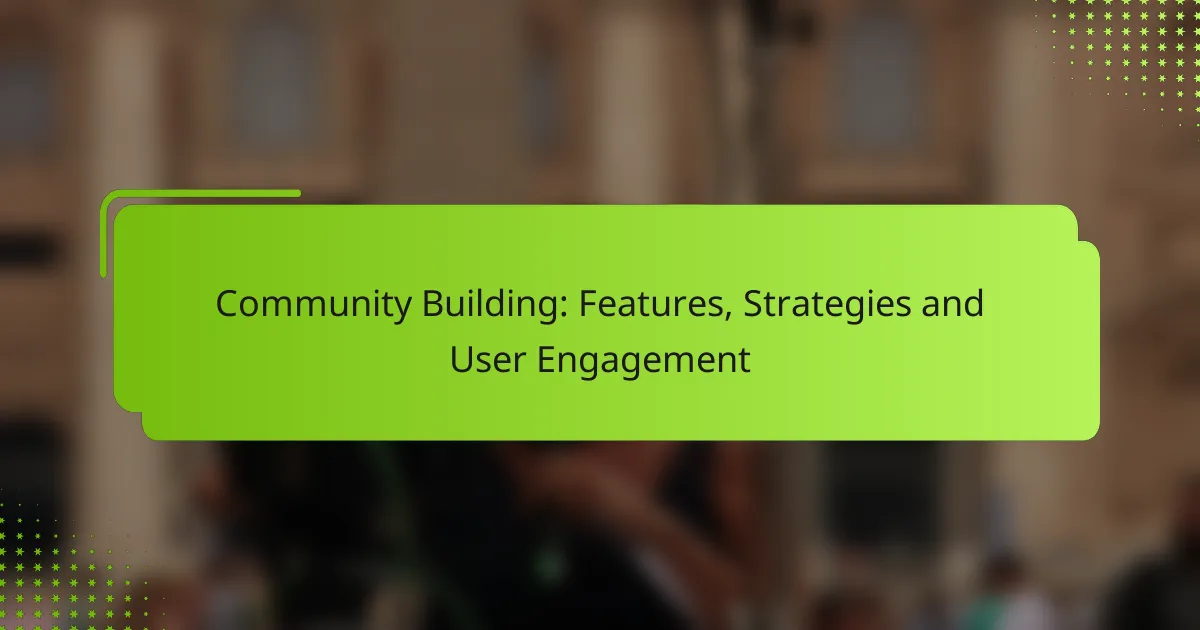Community building is essential for fostering engagement, connection, and collaboration among members. By employing diverse strategies such as online forums, social media interactions, and local events, communities can enhance user participation and create meaningful relationships. Key features like user-friendly interfaces and robust moderation tools further support these efforts, ensuring a safe and engaging environment for all participants.

What are effective community building strategies?
Effective community building strategies foster engagement, connection, and collaboration among members. These strategies can vary widely but typically include online forums, social media engagement, local events, collaborative projects, and gamification techniques.
Online forums and discussion boards
Online forums and discussion boards serve as dedicated spaces for community members to share ideas, ask questions, and engage in discussions. These platforms can be tailored to specific interests or topics, allowing for focused conversations that enhance member interaction.
When setting up a forum, consider user-friendly design and moderation policies to maintain a respectful environment. Popular platforms include Discourse and phpBB, which offer customizable features to suit your community’s needs.
Social media engagement
Social media engagement leverages platforms like Facebook, Twitter, and Instagram to connect with community members in real-time. Regular updates, interactive posts, and live sessions can significantly boost participation and visibility.
To maximize engagement, create a content calendar that includes a mix of informative posts, polls, and user-generated content. Responding promptly to comments and messages fosters a sense of belonging and encourages ongoing interaction.
Local meetups and events
Local meetups and events provide opportunities for face-to-face interactions, strengthening relationships among community members. These gatherings can range from informal coffee meetups to organized workshops or seminars.
When planning events, consider the interests of your community and choose accessible venues. Promote the events through social media and local channels to maximize attendance and engagement.
Collaborative projects
Collaborative projects encourage community members to work together towards a common goal, fostering teamwork and shared ownership. These projects can include anything from group challenges to community service initiatives.
To initiate a successful project, clearly define objectives and roles, and use collaborative tools like Trello or Google Docs for organization. Celebrate achievements to motivate continued participation and build camaraderie.
Gamification techniques
Gamification techniques incorporate game-like elements into community activities to enhance engagement and motivation. This can include leaderboards, badges, or challenges that reward participation and contributions.
Implementing gamification requires careful planning to ensure that rewards align with community values. Consider using platforms like Bunchball or Badgeville to streamline the process and track member progress effectively.

How can user engagement be enhanced?
User engagement can be enhanced through targeted strategies that focus on personalization, incentives, feedback, and interactivity. By implementing these approaches, communities can foster deeper connections and encourage active participation among users.
Personalized content delivery
Personalized content delivery tailors information to individual users based on their preferences and behaviors. This can include recommending articles, videos, or events that align with a user’s interests, significantly increasing the likelihood of engagement.
To implement personalized content, utilize data analytics tools to track user interactions and preferences. Consider segmenting your audience into groups based on demographics or behavior to create more relevant content experiences.
Incentives and rewards programs
Incentives and rewards programs motivate users to engage more actively by offering tangible benefits. This can include points for participation, discounts, or exclusive access to content and events, which can enhance user loyalty.
When designing a rewards program, ensure that the incentives are meaningful and achievable. For example, offering small rewards for daily logins or participation in discussions can encourage consistent engagement without overwhelming users.
Regular feedback loops
Regular feedback loops involve systematically collecting user input to improve community features and content. This can be achieved through surveys, polls, or direct discussions, allowing users to feel heard and valued.
Establish a routine for gathering feedback, such as quarterly surveys or monthly check-ins. Ensure that you act on the feedback received, demonstrating to users that their opinions lead to tangible changes within the community.
Interactive content formats
Interactive content formats, such as quizzes, polls, and live Q&A sessions, engage users by encouraging participation. These formats not only make the experience more enjoyable but also provide valuable insights into user preferences.
Consider incorporating interactive elements into your content strategy. For instance, hosting a monthly live webinar where users can ask questions in real-time can foster a sense of community and keep users coming back for more.

What features are essential for community platforms?
Essential features for community platforms include user-friendly interfaces, robust moderation tools, mobile accessibility, and integration with social media. These elements foster engagement, ensure safety, and enhance user experience, making them critical for any successful community.
User-friendly interface
A user-friendly interface is crucial for attracting and retaining members. It should be intuitive, allowing users to navigate easily without confusion. Consider employing clear menus, straightforward layouts, and visually appealing designs that enhance usability.
To improve user experience, implement features like search functionality, customizable profiles, and easy access to community guidelines. Regularly gather user feedback to identify pain points and make necessary adjustments.
Robust moderation tools
Robust moderation tools are vital for maintaining a safe and respectful community environment. These tools should enable moderators to manage content effectively, including options for flagging inappropriate posts, banning users, and monitoring discussions.
Consider incorporating automated moderation features that utilize AI to detect harmful content quickly. Providing clear guidelines for acceptable behavior can also help users understand community standards and reduce the need for heavy-handed moderation.
Mobile accessibility
Mobile accessibility ensures that users can engage with the community on various devices, which is increasingly important as more people access the internet via smartphones. A responsive design that adapts to different screen sizes enhances user experience and encourages participation.
When developing your platform, prioritize mobile-friendly features such as touch navigation, fast loading times, and offline capabilities. This approach can significantly increase user engagement and retention rates.
Integration with social media
Integrating social media into your community platform can enhance visibility and encourage user interaction. Features like social sharing buttons, login options via social accounts, and content cross-posting can streamline user engagement and attract new members.
Ensure that integration respects user privacy and complies with relevant data protection regulations. Offering incentives for users to share content on their social networks can further amplify your community’s reach and growth.

What are the prerequisites for building a successful community?
Building a successful community requires a clear understanding of its mission, a defined target audience, and effective communication channels. These elements work together to foster engagement and ensure the community thrives.
Clear mission and vision
A clear mission and vision provide direction and purpose for the community. This foundational element helps members understand the community’s goals and motivates them to participate actively.
To create a compelling mission, consider what unique value your community offers and how it addresses the needs of its members. A strong mission statement should be concise and resonate emotionally with potential members.
Defined target audience
Identifying a defined target audience is crucial for tailoring content and engagement strategies. Understanding who your community serves allows for more relevant discussions and activities that meet their interests and needs.
To define your audience, consider demographics such as age, location, and interests. Surveys or social media analytics can provide insights into who is engaging with your content, helping you refine your focus.
Effective communication channels
Effective communication channels are essential for fostering interaction and engagement within the community. These channels can include forums, social media platforms, newsletters, or dedicated apps, depending on where your audience is most active.
Choose channels that facilitate easy access and encourage participation. For instance, a Facebook group might be suitable for casual discussions, while a dedicated forum could support in-depth conversations. Regularly assess which channels are most effective and be open to adapting as your community grows.

How does community building impact brand loyalty?
Community building significantly enhances brand loyalty by fostering deeper connections between customers and brands. Engaged communities create a sense of belonging, leading to increased trust and repeat business.
Features of a Strong Community
A strong community typically includes features such as active engagement, shared values, and open communication. These elements help members feel valued and connected to the brand. For instance, brands that facilitate discussions and provide platforms for user-generated content often see higher loyalty rates.
Additionally, exclusive benefits like early access to products or special discounts can strengthen community ties. These perks encourage members to remain active and invested in the brand, enhancing their overall experience.
Effective Strategies for Community Building
To build an effective community, brands should focus on creating engaging content and facilitating interactions among members. Regularly hosting events, both online and offline, can foster relationships and keep the community vibrant. For example, brands might organize webinars, Q&A sessions, or local meetups to connect members.
Another strategy is to leverage social media platforms where the target audience is most active. Tailoring content to fit the platform’s style can increase engagement and attract new members. Brands should also encourage feedback and adapt based on community input to ensure relevance and satisfaction.
User Engagement Techniques
User engagement can be enhanced through gamification, rewards, and recognition. Implementing systems where members earn points for participation or contributions can motivate them to engage more frequently. For example, a loyalty program that rewards users for sharing content or inviting friends can drive community growth.
Moreover, recognizing active members publicly can foster a sense of appreciation and encourage others to participate. Highlighting user stories or testimonials can also create relatable content that resonates with the community, further solidifying their loyalty to the brand.



